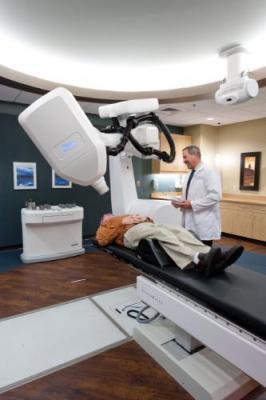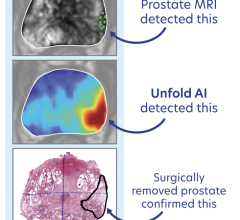
September 27, 2018 — Accuray Inc. announced that published data from two prospective, multi-center studies using differing protocols provide consistent results and reinforce the use of the CyberKnife System for the effective management of low- and intermediate-risk prostate cancer. These studies are the largest conducted to date evaluating stereotactic body radiation therapy (SBRT) in patients with localized prostate cancer. The studies were recently published online in the International Journal of Radiation Oncology*Biology*Physics1 and in European Urology Oncology.2
The CyberKnife System delivers radiation with sub-millimeter precision, enhancing clinicians' ability to treat effectively while preserving healthy tissue. In addition to clinical benefits, SBRT is more convenient for patients and has been shown to be less costly than long courses of intensity-modulated radiation therapy (IMRT).
Growing clinical evidence suggests that dose-escalation may translate to improved clinical outcomes for prostate cancer. Research suggests that, unlike most tumors, prostate cancer cells are highly sensitive to the amount of radiation dose delivered per fraction or treatment session. In recent years, this has led clinicians to consider hypo-fractionated schedules — the delivery of a higher dose per fraction in fewer fractions than conventional schedules — with promising results. SBRT, which combines a high degree of targeting accuracy with very high doses of extremely precise, externally-delivered radiation over four to five sessions, provides an option for accomplishing this goal.
In the studies, prostate SBRT administered by the CyberKnife System resulted in the following disease-free survival rates:
- Ninety-seven to 100 percent for low-risk patients
- Superior to the 92-94 percent from conventional radiation therapy historic data;
- Equivalent to low dose rate (LDR) brachytherapy and high dose rate (HDR) brachytherapy without the inconvenience and risk associated with invasive seed and catheter implants
- Eighty-eight to 97 percent for intermediate-risk patients
- Equal to or higher than the 85-90 percent reported with conventional radiation therapy without the inconvenience of daily visits over several weeks
Despite the high dose delivered to the prostate, side effects were uncommon (less than 2 percent grade 3 or higher toxicities) and were similar to other radiation therapy procedures, without the need for invasive rectal balloons or spacers to spare the rectal wall.
"Our study treated over 300 prostate cancer patients across 21 centers throughout the United States. The CyberKnife's unique architecture tracks and automatically corrects for prostate motion, delivering radiation with sub-millimeter accuracy. This exceptional precision allowed us to give a more effective dose of radiotherapy, which translated into superior cancer control. Since we were able to avoid the healthy tissues which lie immediately adjacent to the prostate, side effects were uncommon," said Robert M. Meier, M.D., medical director of the Swedish Radiosurgery Center in Seattle and lead investigator of the study published in the International Journal of Radiation Oncology*Biology*Physics.
Donald B. Fuller, M.D., radiation oncologist at Genesis Healthcare Partners in San Diego and lead investigator of the European Urology Oncology study, added, "We evaluated an SBRT dosing regimen designed to emulate successful high dose rate (HDR) brachytherapy plans and delivered in four visits. Study outcomes demonstrate that CyberKnife prostate SBRT is safe and effective for low- and intermediate-risk prostate cancer patients, producing a lower PSA [prostate-specific antigen] nadir level than previously reported with other external radiotherapy techniques (< 0.1 ng/mL at 4 years and beyond), with minimal impact on quality of life during and after treatment. Of note, our treatment plans required steep dose fall-off from high-dose regions close to the bladder, urethra and rectum that would be difficult to deliver safely without the unique continual image-guidance and automatic correction of the beam aim made possible by the CyberKnife System."
For more information: www.accuray.com
References


 April 10, 2024
April 10, 2024 








